Johannes Ackva: An update to our thinking on climate change
By EA Global @ 2020-09-15T13:44 (+51)
This is a linkpost to https://www.youtube.com/watch?v=yfBzoCPQ8Kc&list=PLwp9xeoX5p8NfF4UmWcwV0fQlSU_zpHqc&index=13
In this talk and Q&A, Johannes Ackva, a researcher at Founders Pledge, presents the organization's thinking on effective climate solutions. He shares insights from their latest research, including a novel framing of the issue, key conclusions from their report on climate and lifestyle, updates on their research on high-impact charities, and more.
We’ve lightly edited Johannes’ talk for clarity. You can also watch it on YouTube and read it on effectivealtruism.org.
The Talk
Arden Koehler (Moderator): Hello, I'm Arden. Welcome to this session on climate change with Johannes Ackva. Following a 20-minute talk by Johannes, we'll move to a live Q&A session in which he will respond to [audience members’] questions. [...]
Let me introduce the speaker for this session. Johannes Ackva has been involved in environmental activism since his teens. He joined the research team at Founders Pledge last year, bringing five years of experience working in a think tank, where he advised decision makers on climate policy. He first started thinking about climate from an EA [effective altruism] perspective in 2016 as a side project, and now it's the focus of his research at Founders Pledge.
Johannes holds an MA in social sciences from the University of Chicago and an MSc in sociology with a focus on research methods from the University of Groningen. Here's Johannes.
Johannes: Hello everyone, my name is Johannes Ackva, I'm with Founders Pledge and I'm looking forward to talking with you about how we think about climate change and what we think we should do about climate change from an effective altruism perspective.
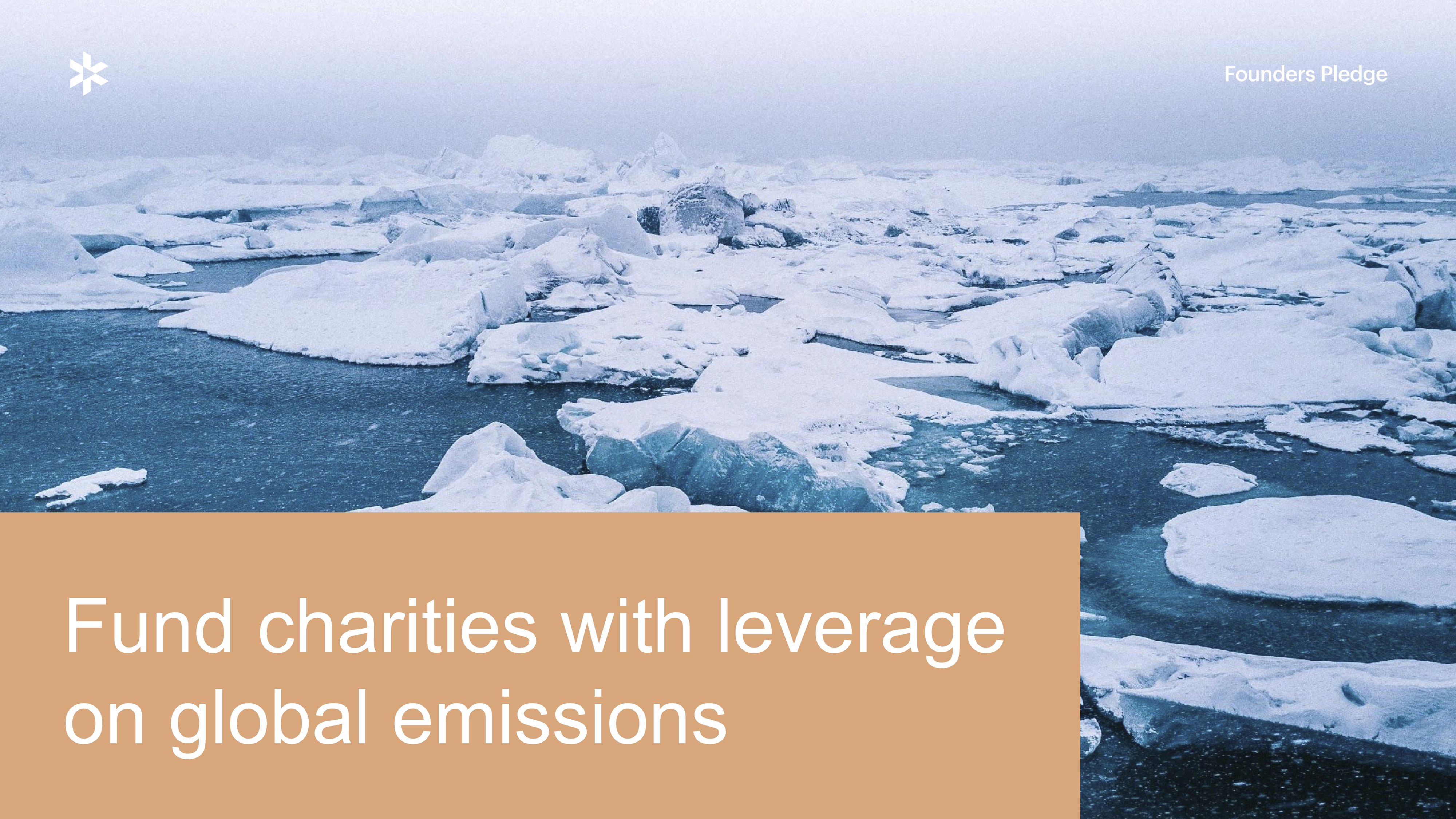
I’ll start with a conclusion. We think the best thing to do around climate is funding charities with leverage on global emissions. Over the course of this presentation, I'm going to explain how we [arrived] there and what this means concretely, but this is my top-level message.

What can you actually do about climate change? The natural thing to think of first is our lifestyle decisions, like changing our consumption behavior, switching to electric cars, flying less, buying cleaner energy, et cetera.

Our climate lifestyle report shows the impact of this [and includes the assumption] that you're inspiring 10 other people to do the same thing. For example, by switching to an electric car and inspiring 10 other people to do the same, you can save around 20 tons of carbon.
Let's compare this to donating $1,000 to our top climate charities. In this case, our assumptions are very pessimistic; [we’ve assumed that] you're not going to inspire anyone else. And even though the cost-effectiveness estimate [for lifestyle decisions] is [multiplied by 10 as a result of the above assumption], a $1,000 donation has 100 times the impact on climate.
The point of this is not that you shouldn't make lifestyle changes. The point is that when you think about the actions available to you, [you should consider] donations as well, because they're very important and allow you to leverage [your impact] far beyond what you can do by changing your lifestyle. [There’s much more in the] report, but this is the [message I’m emphasizing] today.
The key phrase is, of course, “our climate charities.” Like other good EA organizations, we believe that the very best charities are 10 to 100 times better than the worst charities, or even average charities. But to understand which charities are the very best, we need to understand the nature of the challenge, which affects the strategies and charities in [the climate change] space.
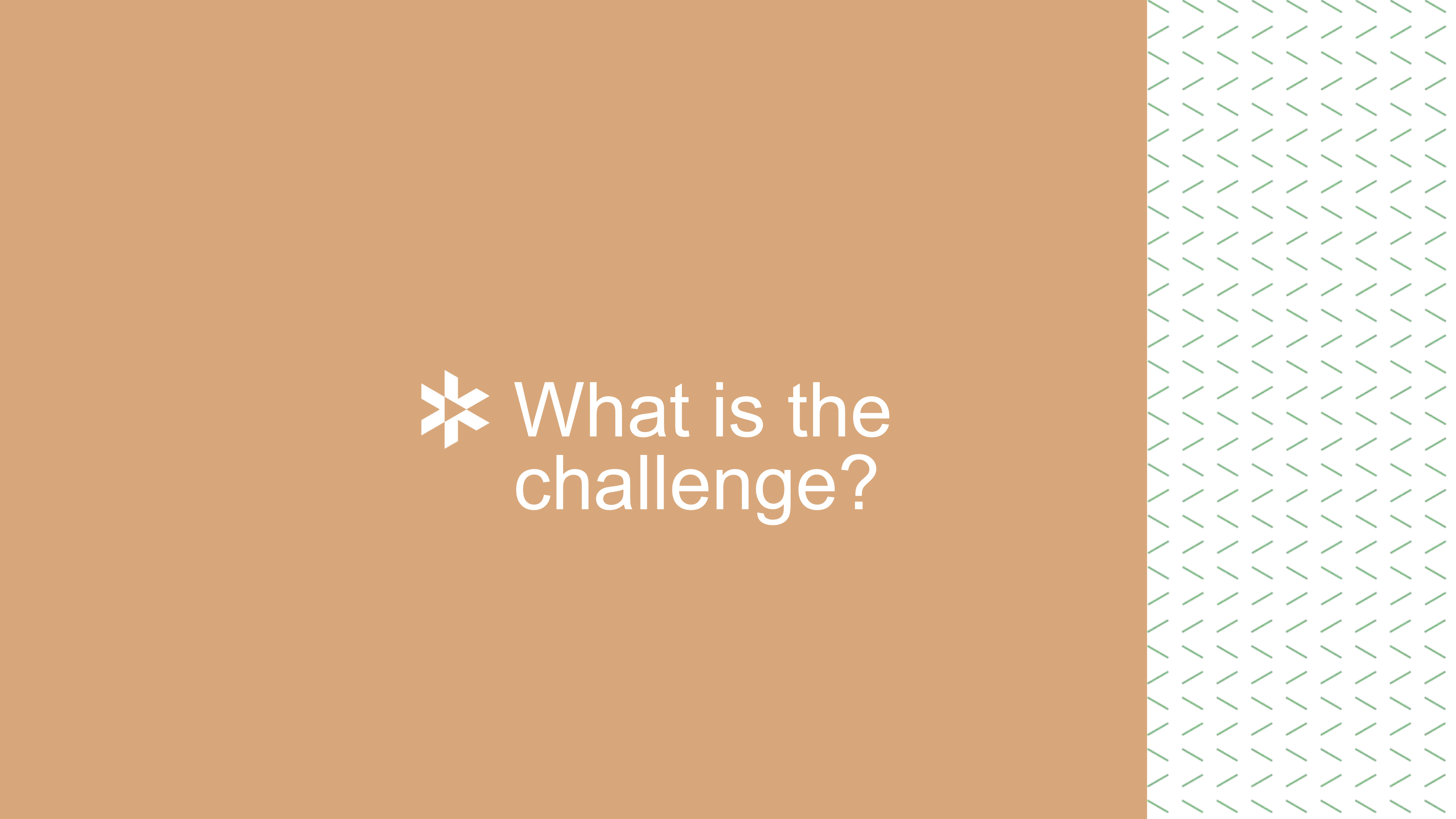
The first thing to know is that climate change is [about more than the climate], even though we talk about that the most. It’s part of a triple challenge, because climate change is mostly about solving an energy problem.

Carbon energy contributes to about 80% of global human-based emissions. This is key, and it interacts with other issues that I'm going to talk about.
Before I do, though: we're currently on a path [leading to] three degrees of warming, and there's a more than 1% chance [that we’ll experience] six degrees of warming. Three degrees would certainly be really bad. Six degrees of warming would create an almost unimaginably different world from the one that we’re living in now.
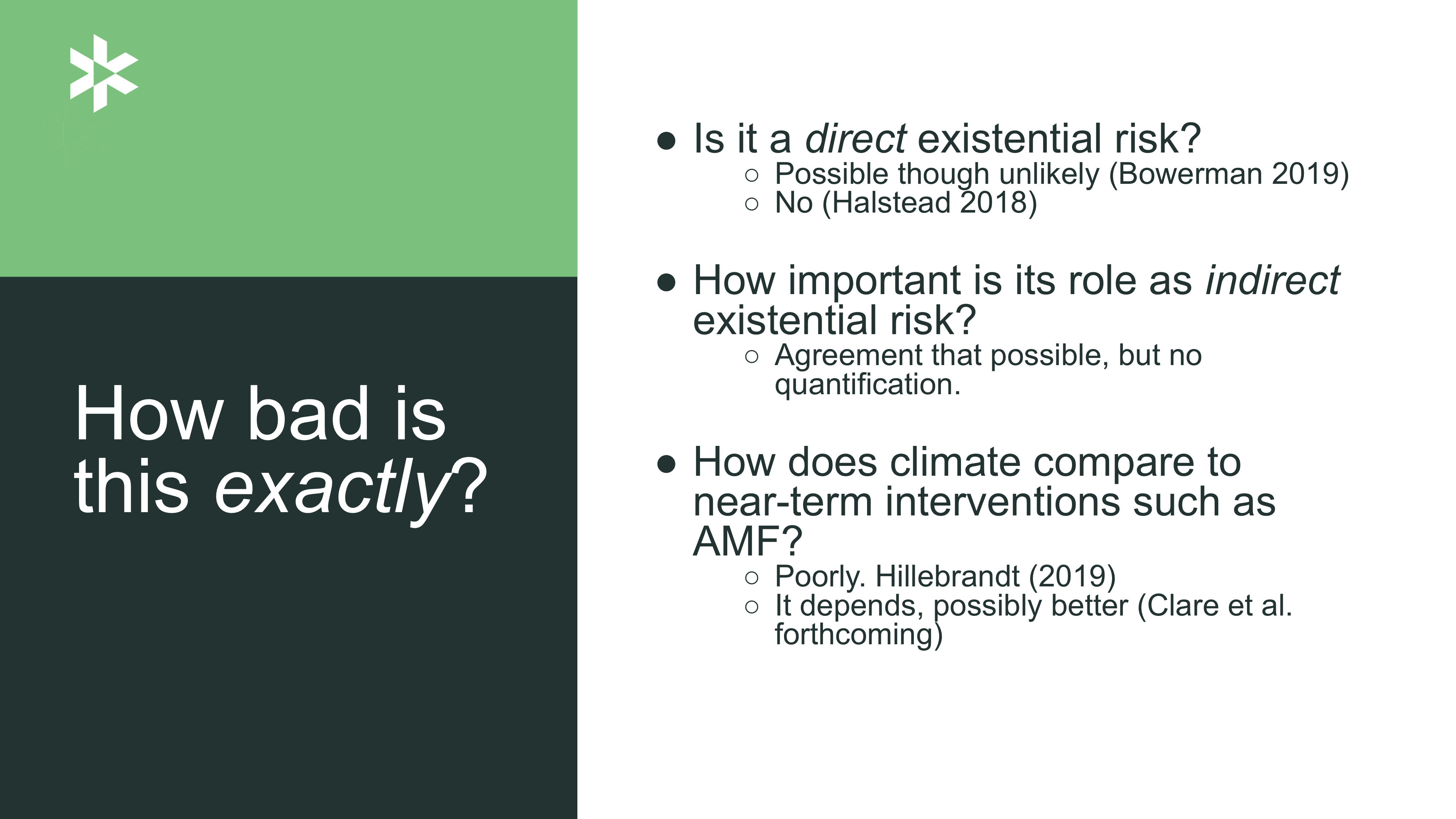
Of course, we also want to know exactly how bad this could be. And how does this [threat] compare to other issues that [the effective altruism community] cares about?
I think there have been roughly three kinds of questions posed in relation to that in the EA community:
1. Is climate change a direct existential risk? I think that there's a bit of disagreement. In 2019, Neil Bowerman gave a talk at EA Global in which he came to the conclusion that it could be, even though it's unlikely. And there's prior work my colleagues have done in-house; they separately came to the conclusion that it's probably not. In any case, this is not a very likely scenario.
2. Is climate change an indirect existential risk? There is agreement that there could be indirect existential risk factors related to climate change — and that this is worrisome. Climate change can increase political instability and conflict, which makes other existential risks, such as great-power risk, more likely. But as far as I know, there's no solid quantification of the extent to which that adds to the importance of climate change in our thinking. This is very much a research frontier, and unfortunately, I can't say anything smart about it right now.
3. How does climate change compare to more near-term interventions, such as global health interventions? Hauke Hillebrandt made the argument in 2019 that it probably compares relatively poorly. My colleague Stephen Clare and I are also working on this question. [Our overall] view is that it depends; actually, it's quite imaginable that climate compares very favorably. The main difference is [in how we calculate the] social cost of carbon. I can go into more detail on this in the Q&A.
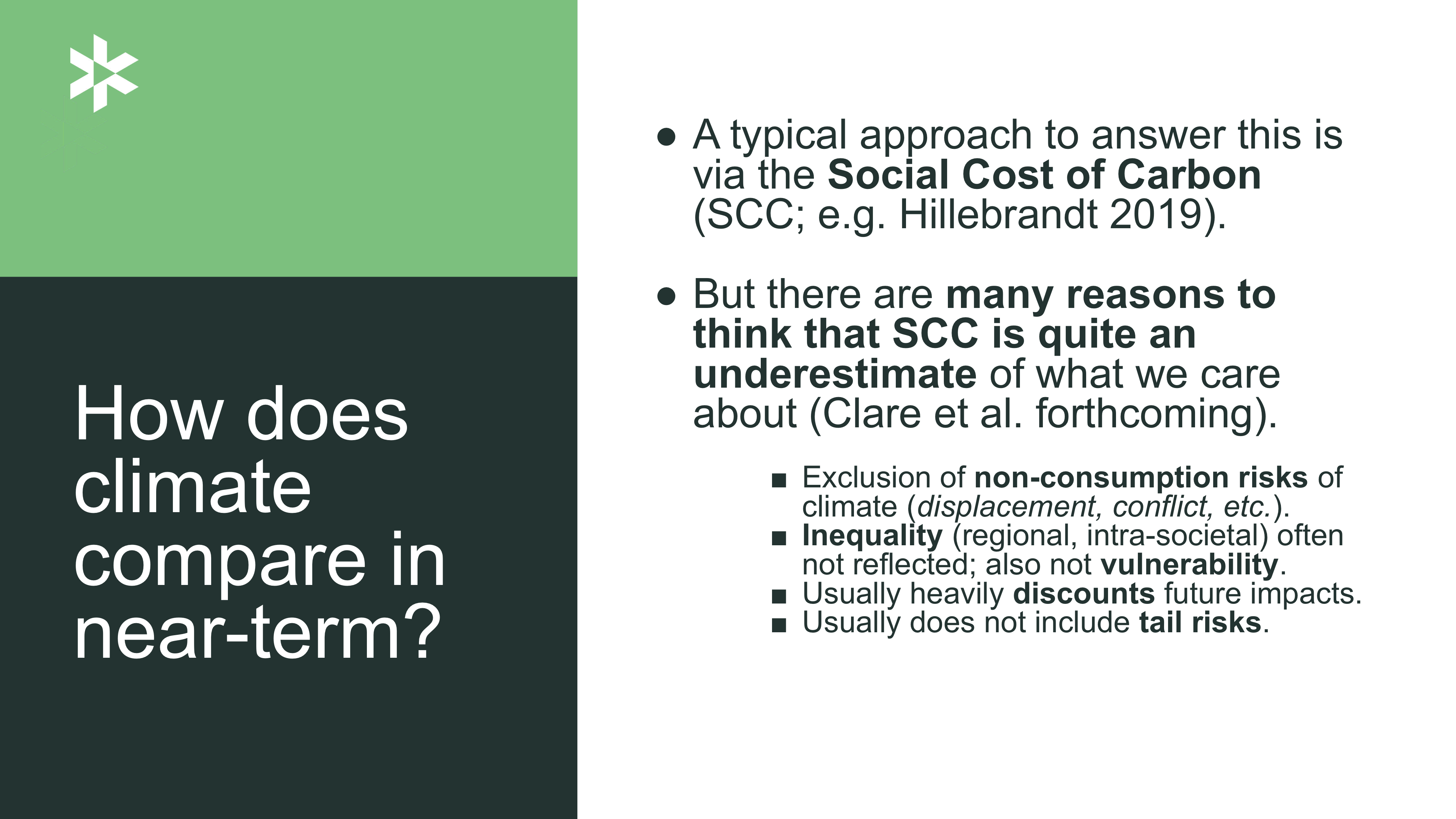
This is just the first part of the triple challenge.

The second part is air pollution. There are at least 5 million premature deaths per year from air pollution, [an outcome that] is split rather evenly between [fossil fuel-based] air pollution and indoor air pollution from biomass. This is a significant public health problem — one that we talk about much, much less than climate change. But from a near-term perspective, air pollution is of similar importance. And you can see this [on the slide below].
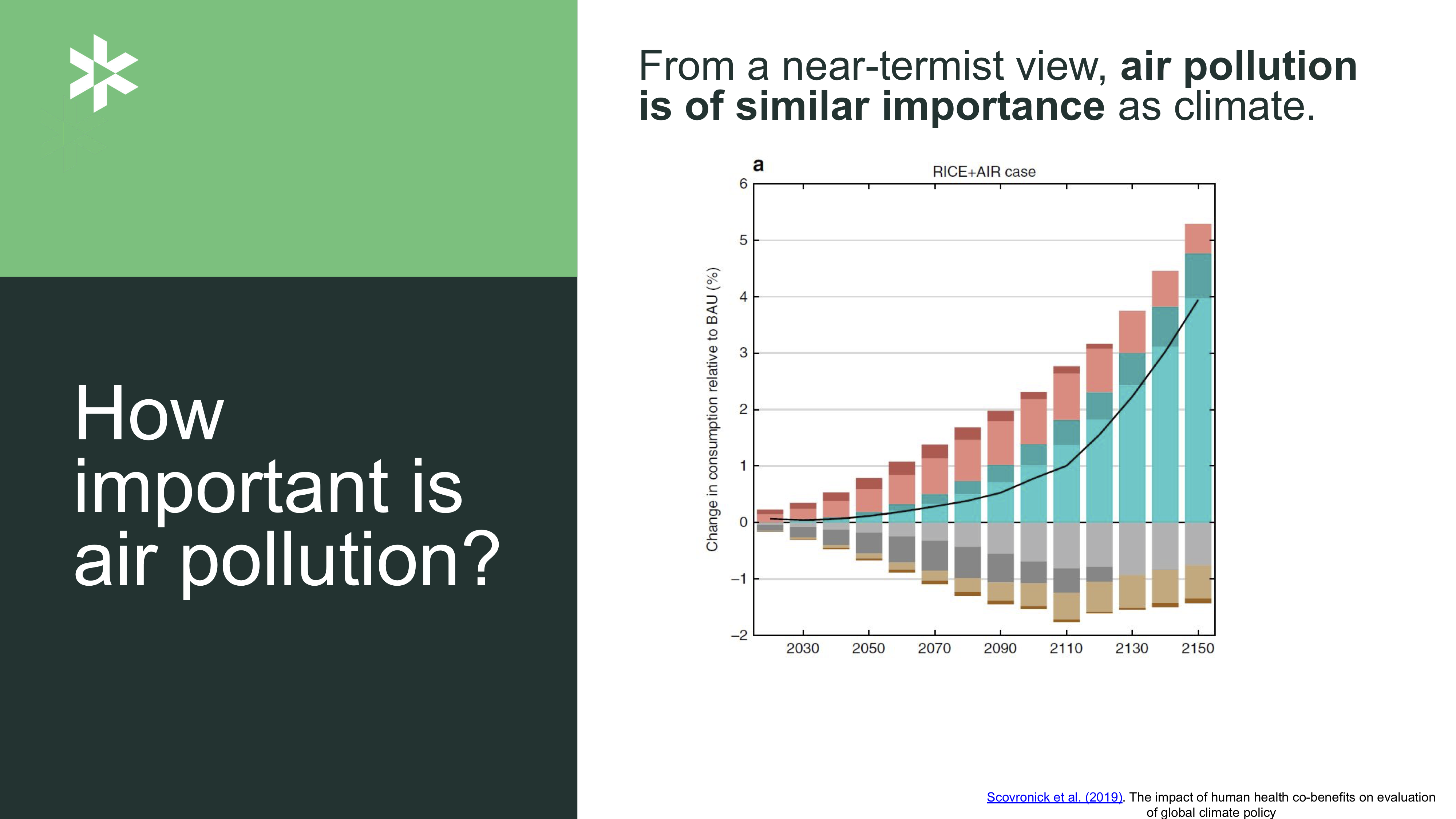
The x axis [shows the passage of] time, and [the y axis] shows the [impact of human health co-benefits on the evolution of global climate policy]. The benefits in red are those related to air pollution, and the benefits in blue are related to more conventional [impacts of climate change]. As you can see, for at least the next few decades, the air pollution benefits outweigh the climate benefits. This changes over time because [there’s a lag with many] climate impacts, but there’s strong reason to think that air pollution is an important [consideration]. We're [planning to publish] work on this later this year; we’ve come to the rough conclusion that this co-benefit can be a significant addition to the cost-effectiveness of climate charities.
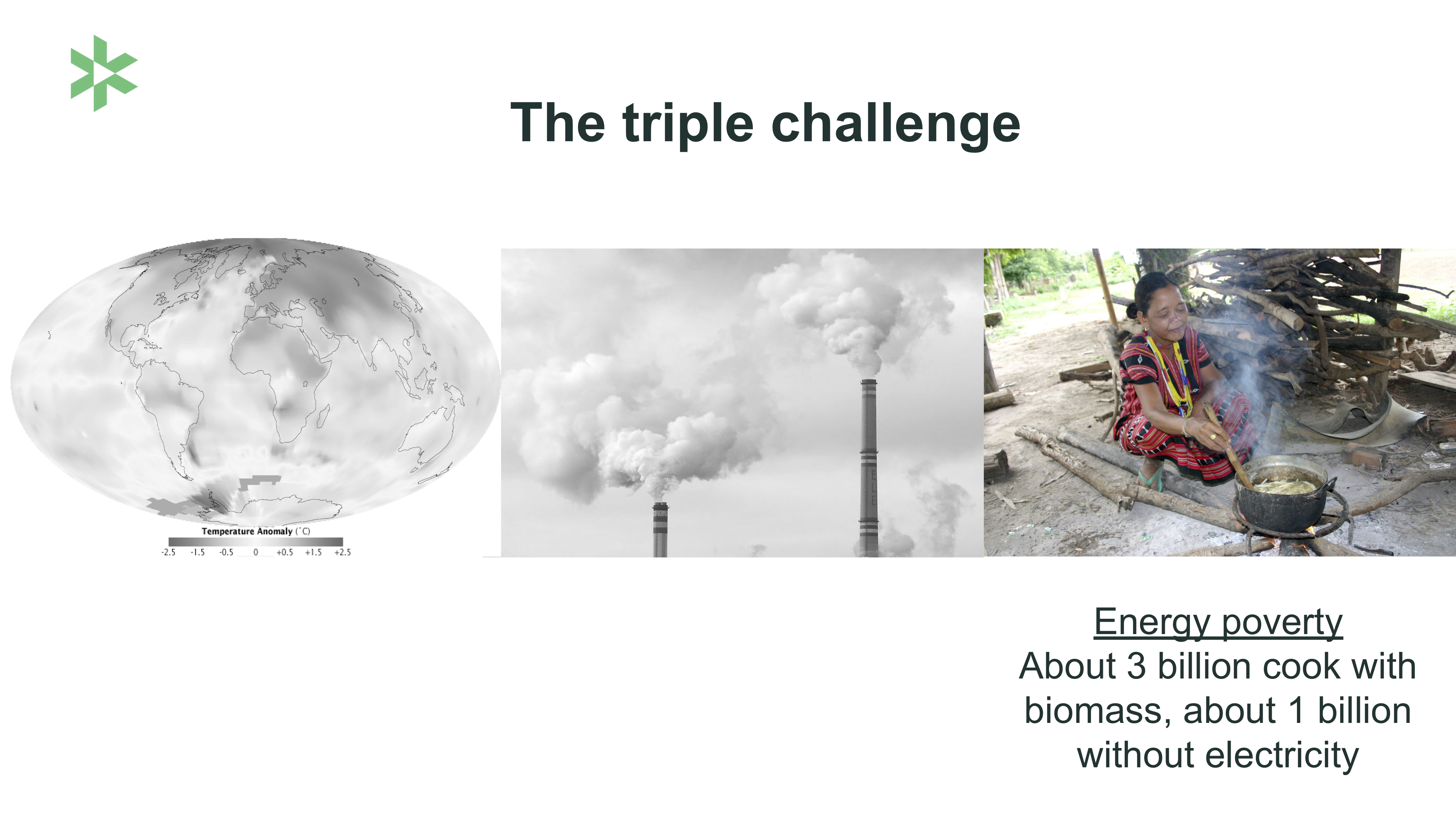
The third part of the triple challenge is around energy poverty. Right now, about 3 billion people are cooking with biomass, and one billion people don't have access to electricity. These statistics hide a much wider amount of energy poverty. This is important because having more energy is very closely tied to human development.
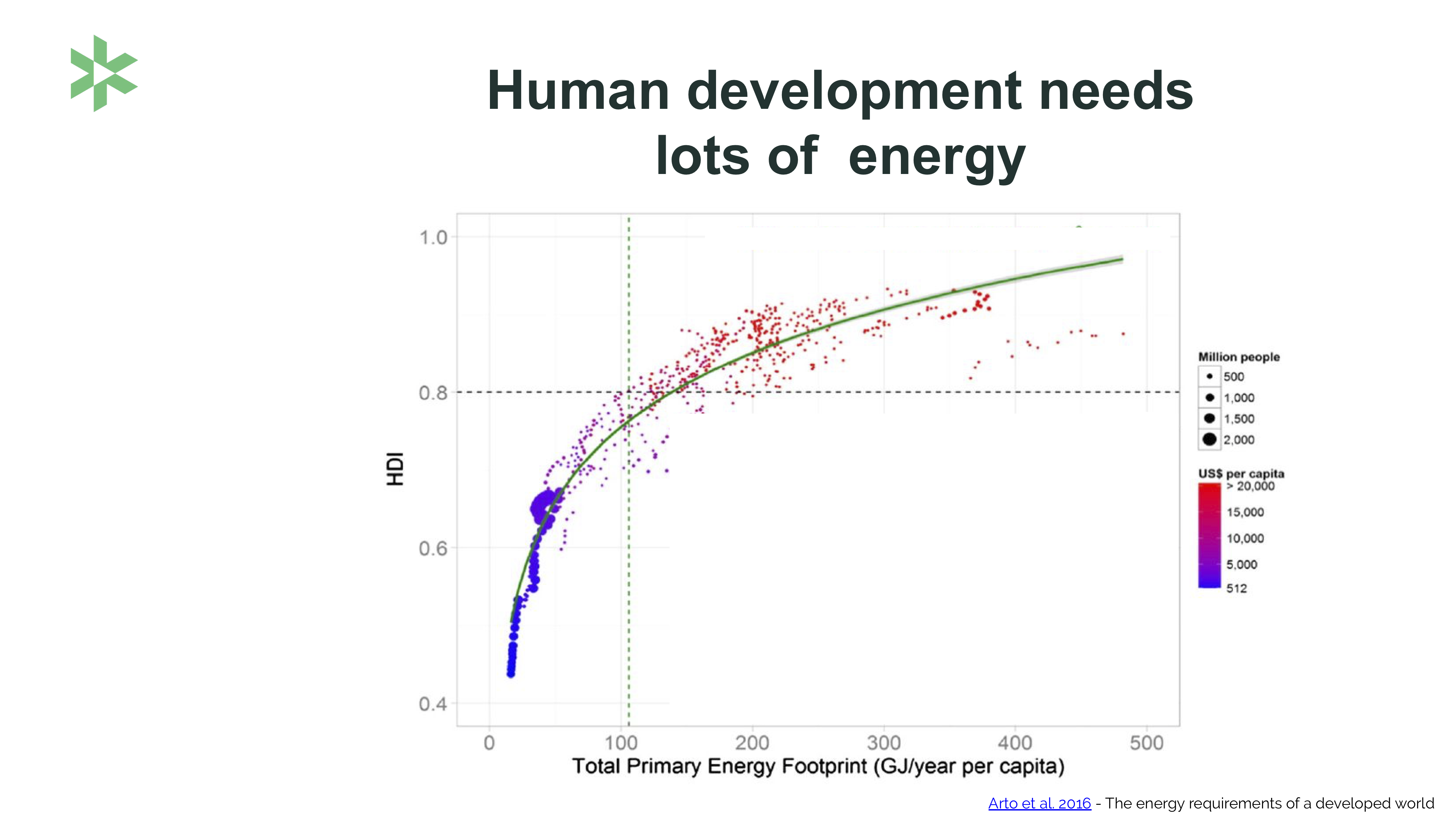
This graph [shows] the human development index [relative to] our energy footprint. Most of the global poor [are represented] in the area of the graph between zero and 100 [on the y axis]. That [indicates] a very strong relationship between having more energy and better human development. This is not a one-way street in terms of causality; if you're working for a world where the average human is much richer than they are today (especially the global poor), you should expect the global energy demand to massively increase.
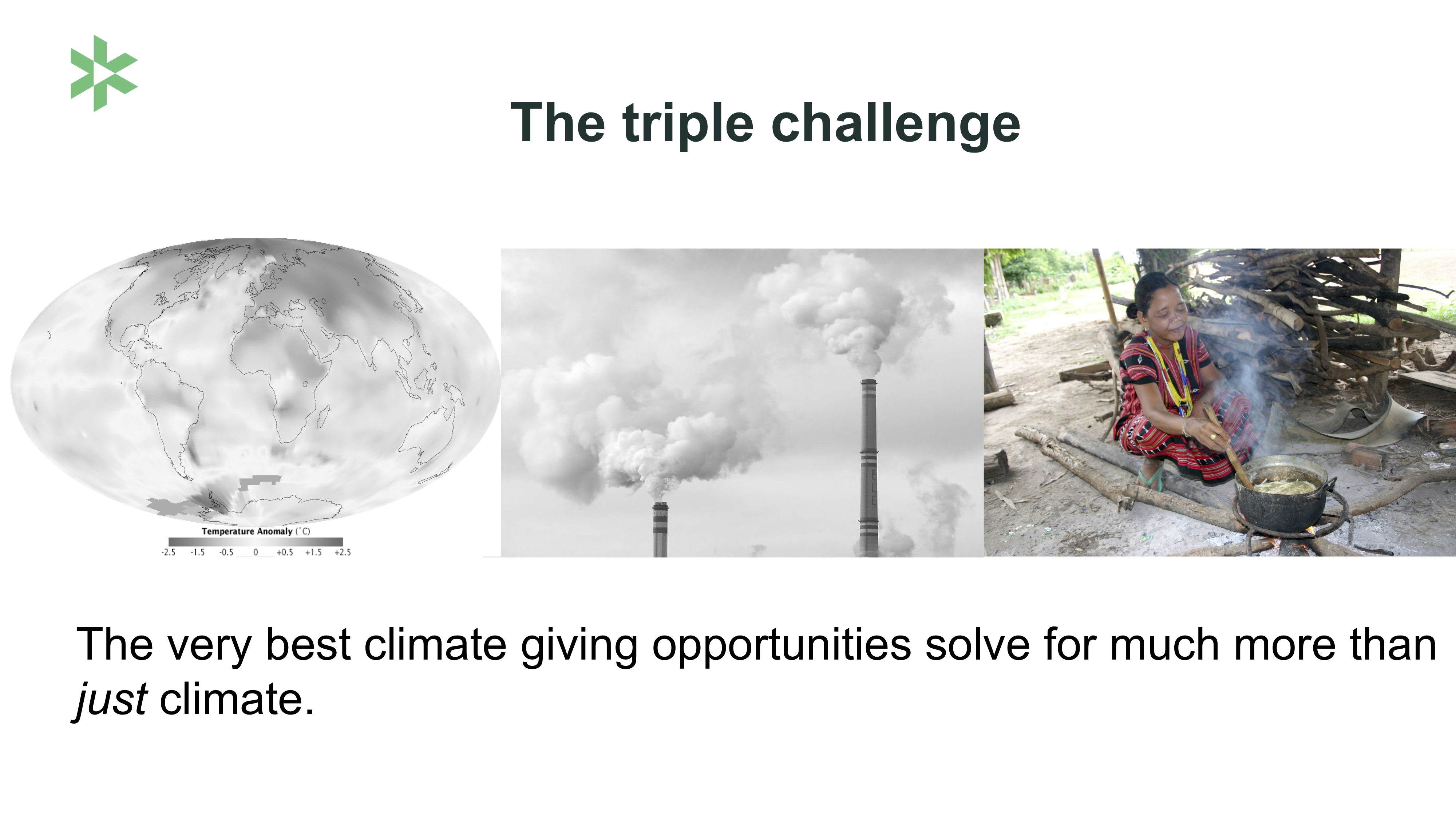
The bottom line, when thinking about climate as a triple challenge, is that the very best climate opportunities solve for much more than just climate. They have other significant benefits, and we also need to look for solutions that work in a world where energy demand is increasing. Increasing clean energy can also help with energy poverty — but it also sometimes creates tension. That's something to be aware of.

So how are we actually doing? Where are we in addressing the problem of climate and the related problems around energy poverty and air pollution?

Energy growth has, to this point, [primarily been] fossil fuel growth. You can see in this graph that energy demand has massively increased since 1950. Low-carbon energy is about 10% right now, and that hasn't changed very much. Solar and wind have gone up, but overall, low-carbon sources have gone down, and their share [of energy growth] is still very low. That's where we are right now.

This is a beautiful chart [showing] where we need to go. Essentially, if you take climate policy targets seriously, by about 2050, 90% of high-carbon energy needs to go down to zero. At the same time, by the end of the century, we need to double — or maybe even triple — the overall amount of low-carbon energy. This gives you a sense of how vast this challenge really is. It’s daunting.

For me, the key message from this is to look for solutions that can make an impact on global emissions — and that are as effective as possible. If we all do just a little bit, [or implement solutions] that are just okay (but not great), we're not going to solve this problem. This is where the impetus for finding the highest-impact options comes from.
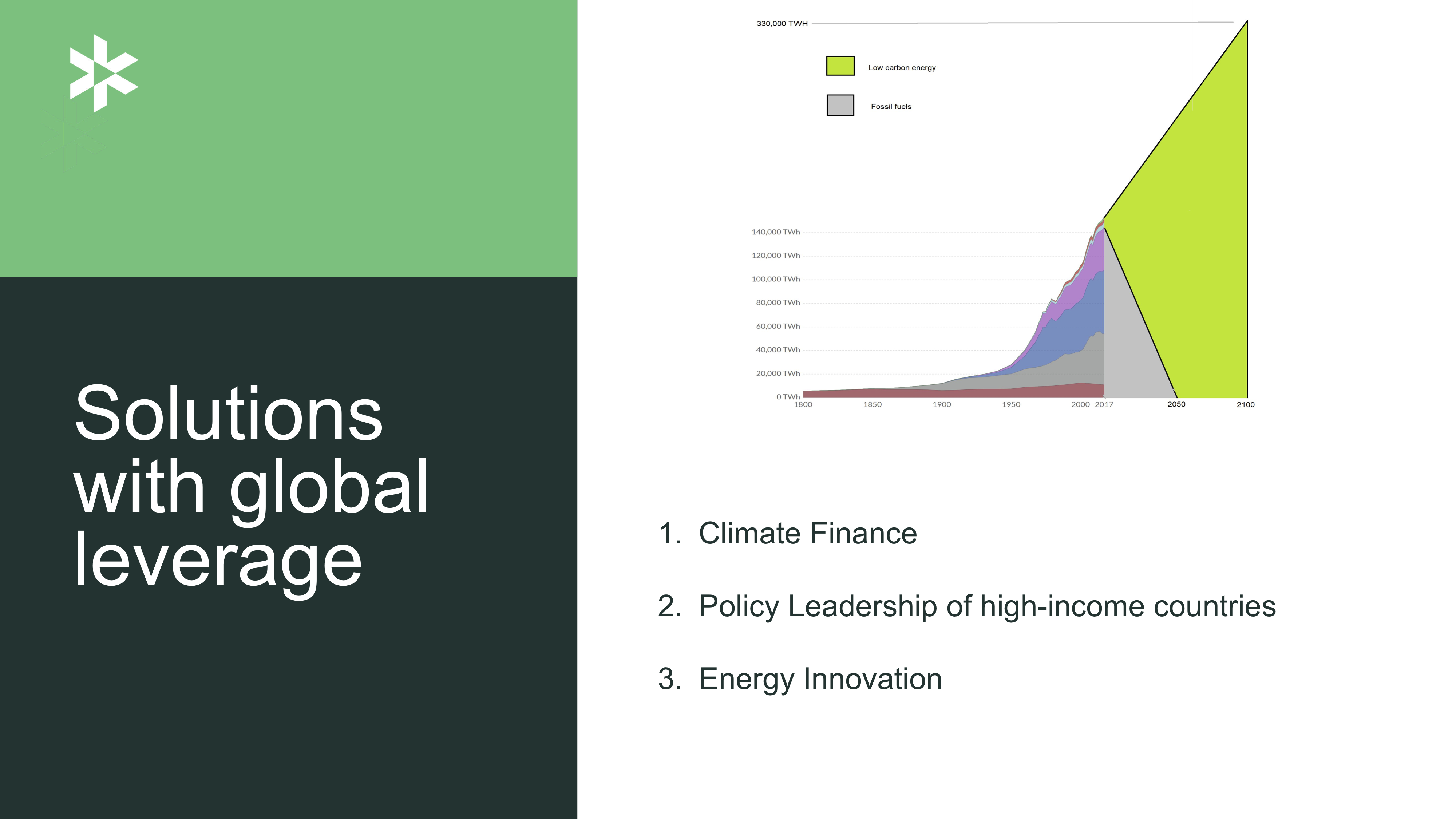
There are three different strategies that we think can [provide] global leverage:
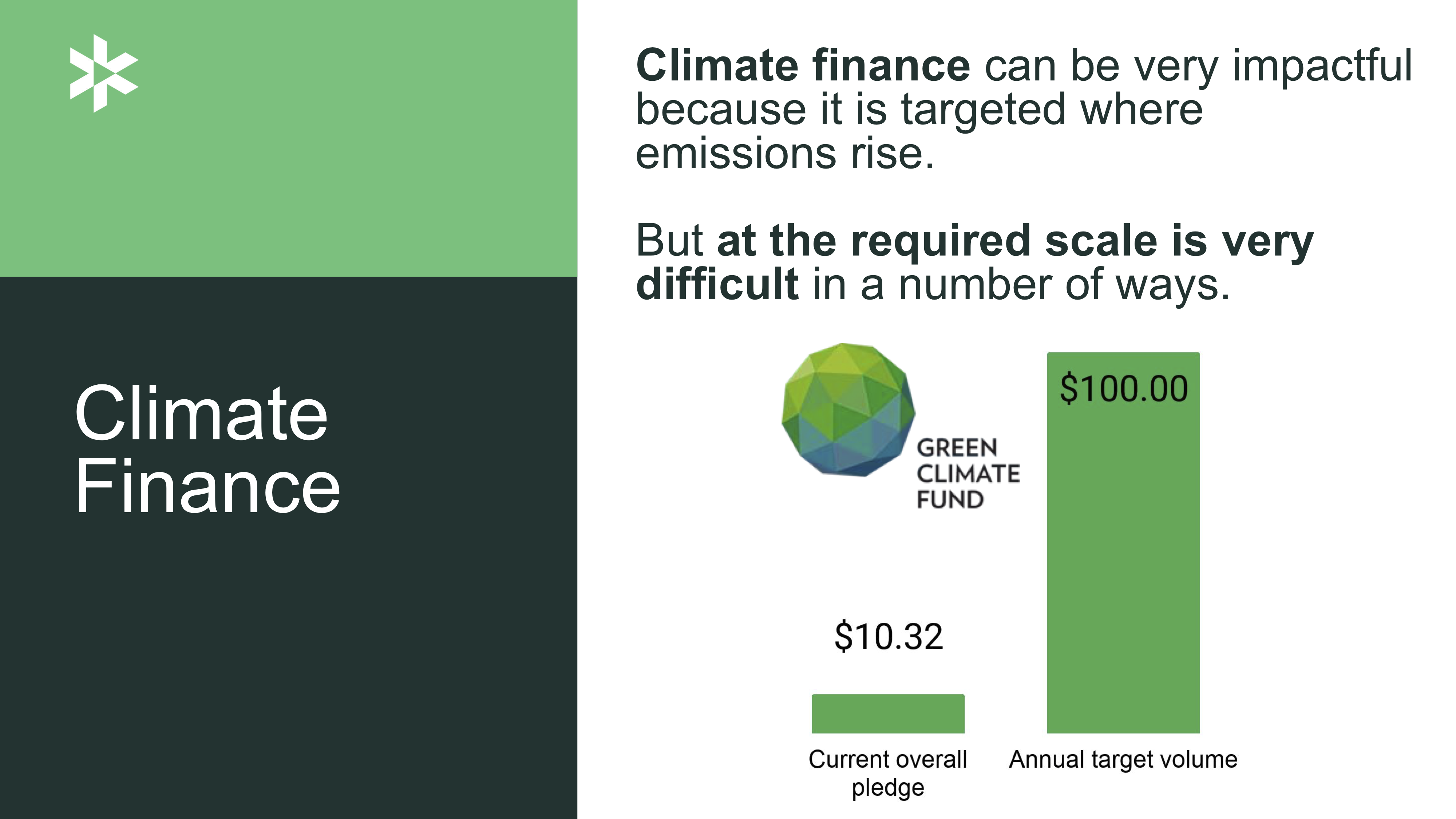
The first is climate finance. Financing emissions abatement in developing countries could be high-impact; it targets locations where emissions rise, where avoiding emissions is usually cheap, and where it’s often difficult to [take action] at the required scale. But there seems to be very little appetite for funding this — for example, the Green Climate Fund has the goal of reaching $100 billion per year to disperse toward international climate finance, but has only collected about $10 billion (and that’s in total, not per year).
There are also very real issues that make [climate finance] hard: the degree of international cooperation required and the need to [frequently determine] which additional climate actions to finance. Reasoning about counterfactuals is hard in the best of worlds, but with over 200 countries and so many different interests, it’s even harder. This is not to say that there cannot be effective solutions. But it's not as good as it looks at first glance — which experience with the Clean Development Mechanism has shown.
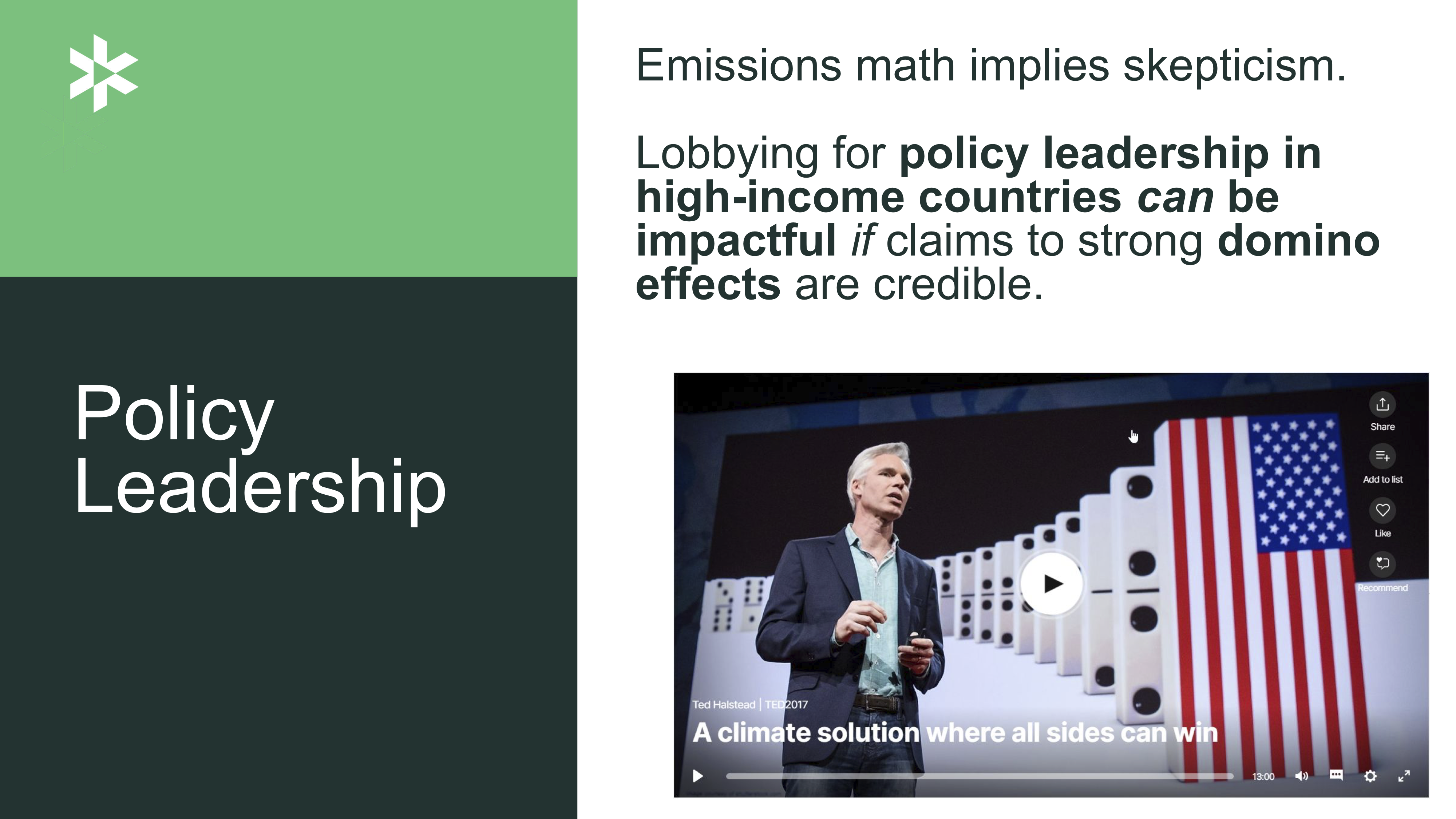
The second highly effective lever is policy leadership in high-income countries. This is not motivated by the emissions math in those countries, because as I've shown, most of the growth in emissions is not going to be in OECD [Organisation for Economic Cooperation and Development] countries. And the OECD economies often already have strong climate policy in place, so you should be quite skeptical. But — and this is a big “but” — it can be very effective if there's a strong domino effect, and a lot of other countries adopt similar policies in reducing emissions. We're currently investigating one charity that falls into this bucket: the Climate Leadership Council. The domino effect [is at the heart of] the argument in their TED Talk. The idea is to push carbon pricing in the US, inspiring other countries to follow suit. We’re also investigating the trade component. I’d be happy to talk more about this during the [Q&A].
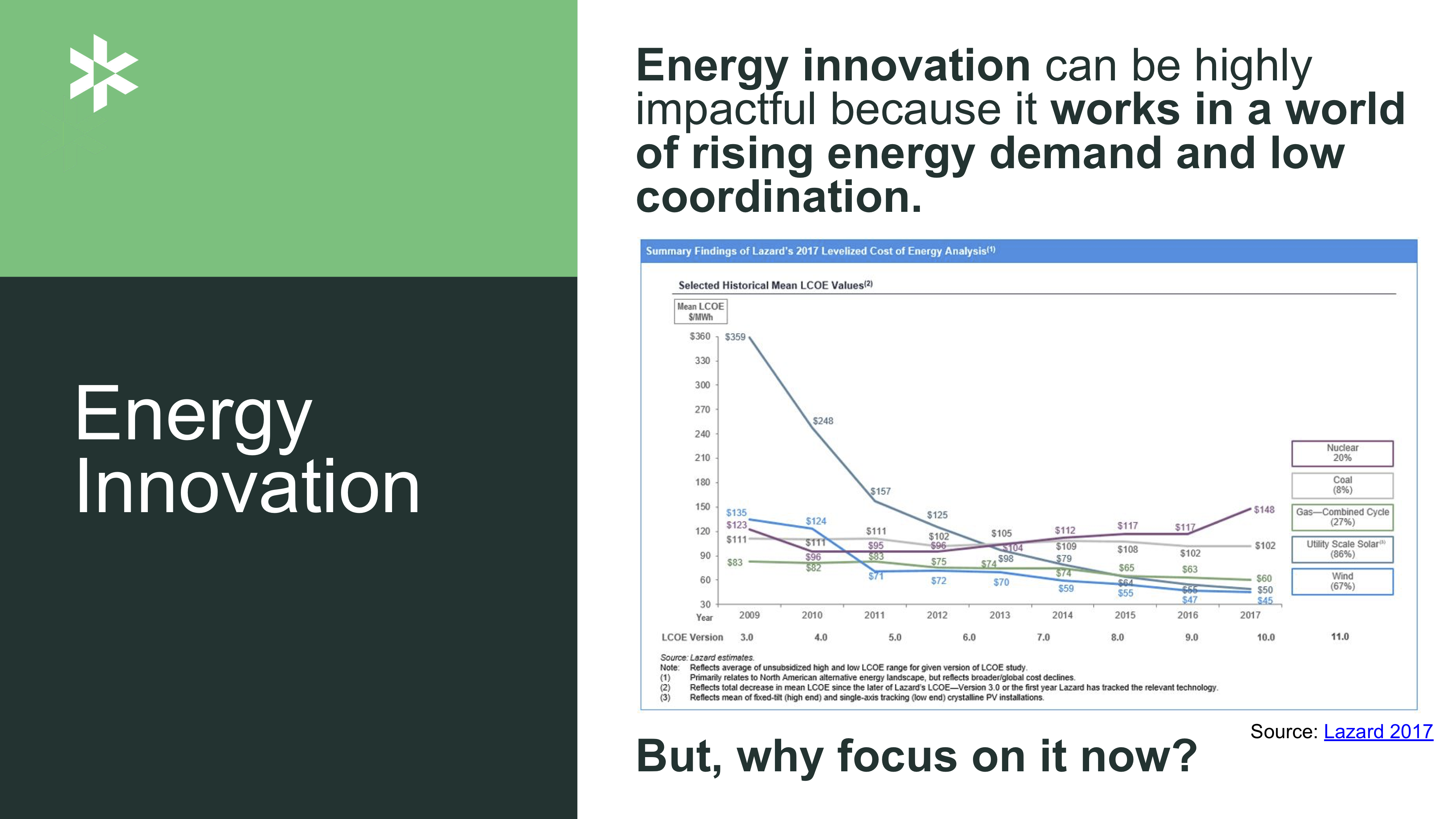
The third lever, which has been the primary lever that we've been working on, is energy innovation. Why would this be great? It’s a lever that works in a world of rising energy demand and low coordination. Essentially, a few countries could decide that they wanted to make solar and wind energy cheap. And they did that. This changed the game, which makes this an attractive [option].
But the question, of course, is, why should we focus on that now? You could say that it's not necessary anymore, because wind and solar have already succeeded. Or you could say it's too late, because [the problem of] climate change is too urgent. So we need a bit more justification for why [energy innovation] would be such a good lever. That's what I'm going to talk about next.

First, in the current climate policy situation, we’re still quite far from the goal of net-zero emissions. About a quarter of emissions are from classical industrial sectors like iron and steel, cement, electricity, aviation, and shipping. Existing solutions to decarbonize those are not great. They’re either too expensive or not scalable — or both. We need more technological innovation in those spaces.

The challenge is much deeper, though. [Researchers at] the International Energy Agency, which provided the analysis [in the slide above], think that only seven out of the 39 technologies [deemed] necessary for climate success are on track.
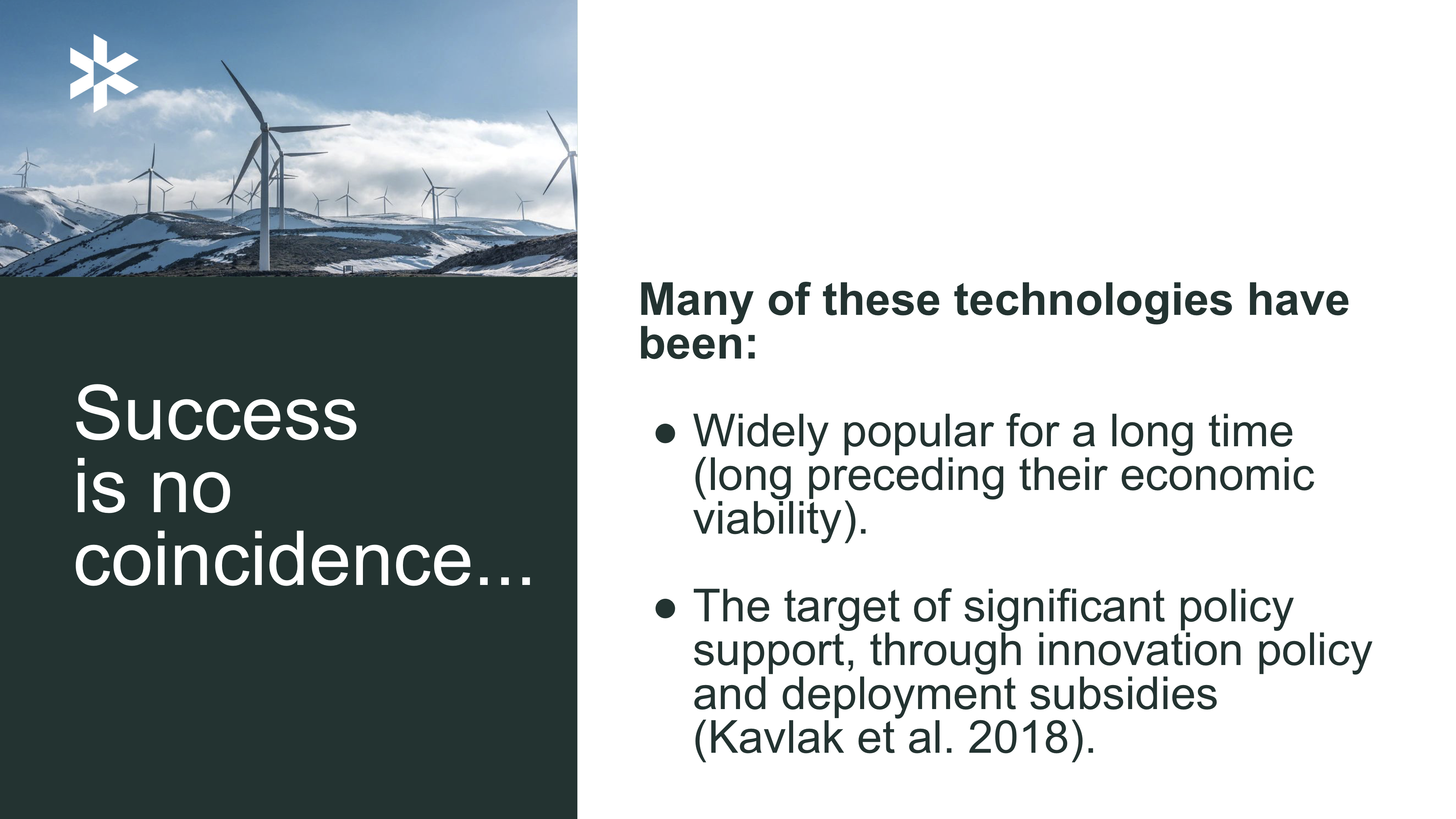
It makes sense to look at those seven, [which include] solar, electric vehicles, rail, and lighting — a lot of technologies that we know and like. We think this is no coincidence. Many of these success stories are technologies that have been widely popular for a long time — long before they were economically viable. For example, solar has arguably been very popular since the 1970s, which has enabled a lot of support for innovation policy and deployment subsidies. Both of those have really helped to drive down the cost of those technologies and make them competitive. But we must pay more attention to the neglected technologies.
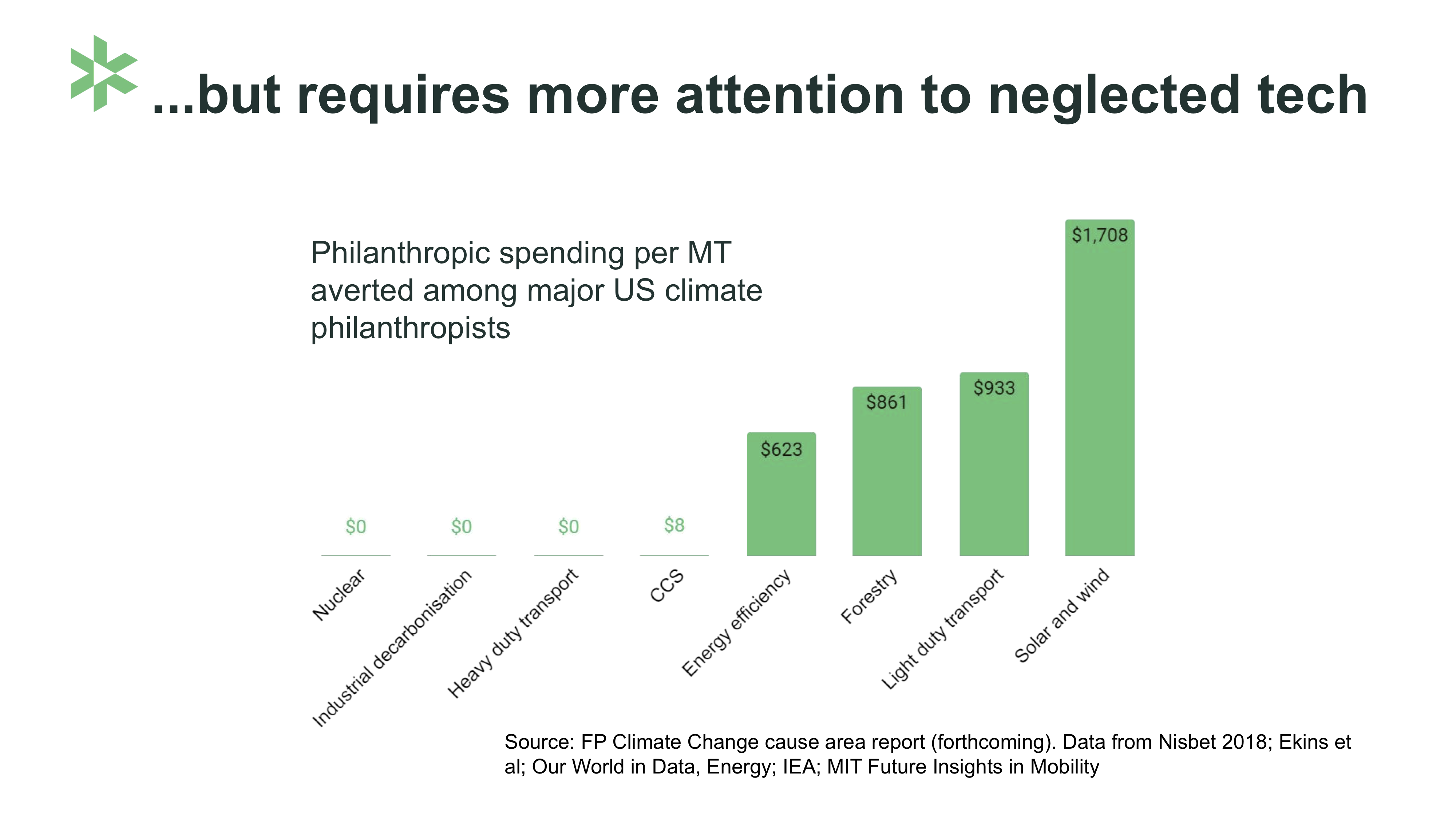
[This slide shows] spending in the US by major philanthropists per megaton [of emissions] averted, by technology. You can see there has been a lot of funding for solar and wind, light duty transport, electric cars, forestry, and energy efficiency, but almost no support for carbon capture and storage, or to decarbonize the heavy duty transport, industrial, and nuclear sectors. This is tragic because [improving] all of these technologies is necessary to get to zero emissions. We need to shift at least some of the philanthropic attention to [the neglected areas in order to] go forward. There’s huge leverage to be had there.
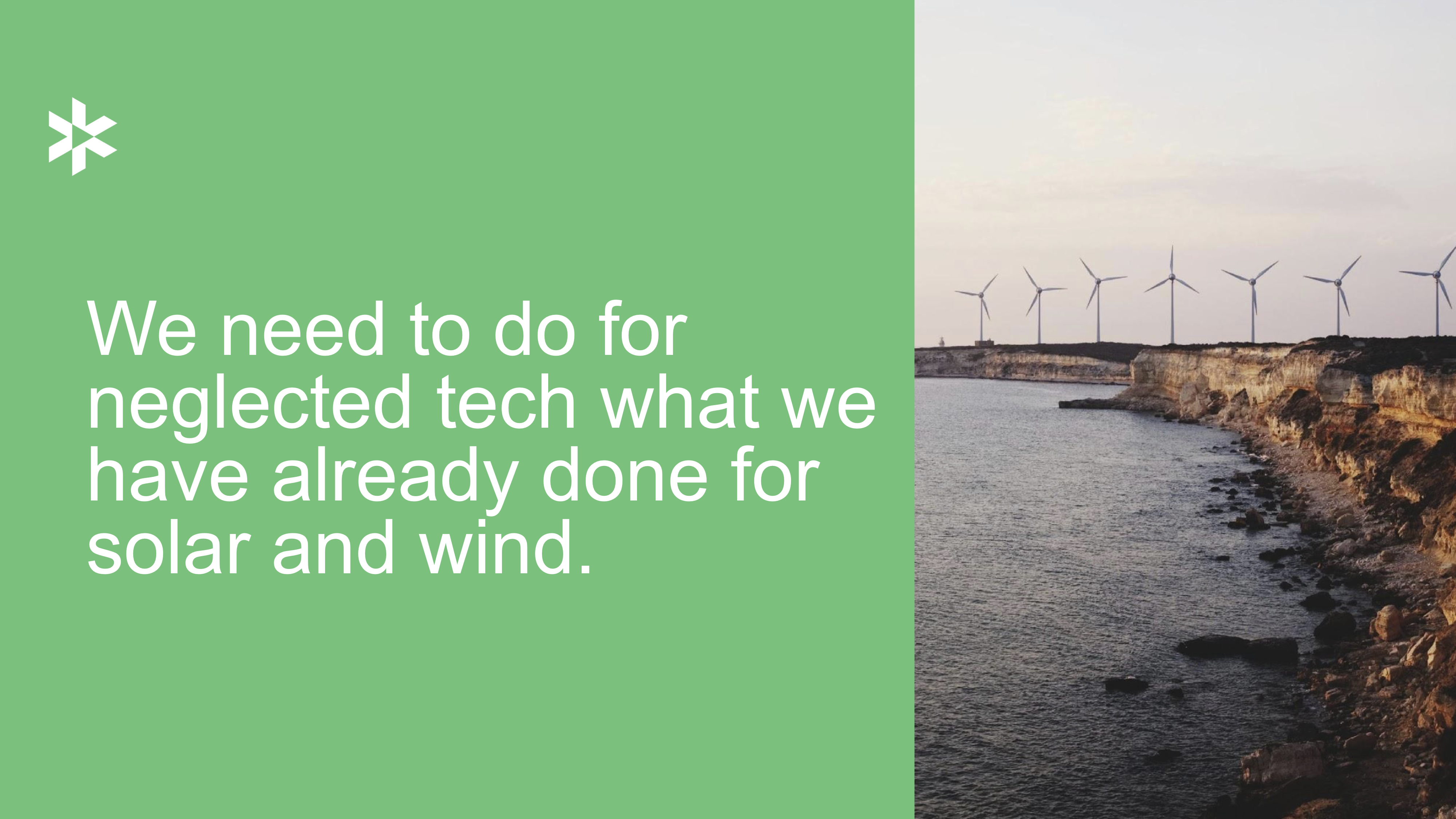
This is our main conclusion about innovation: We need to take the same steps we’ve already taken in solar and wind for other technologies. The good news is we believe that’s [feasible].
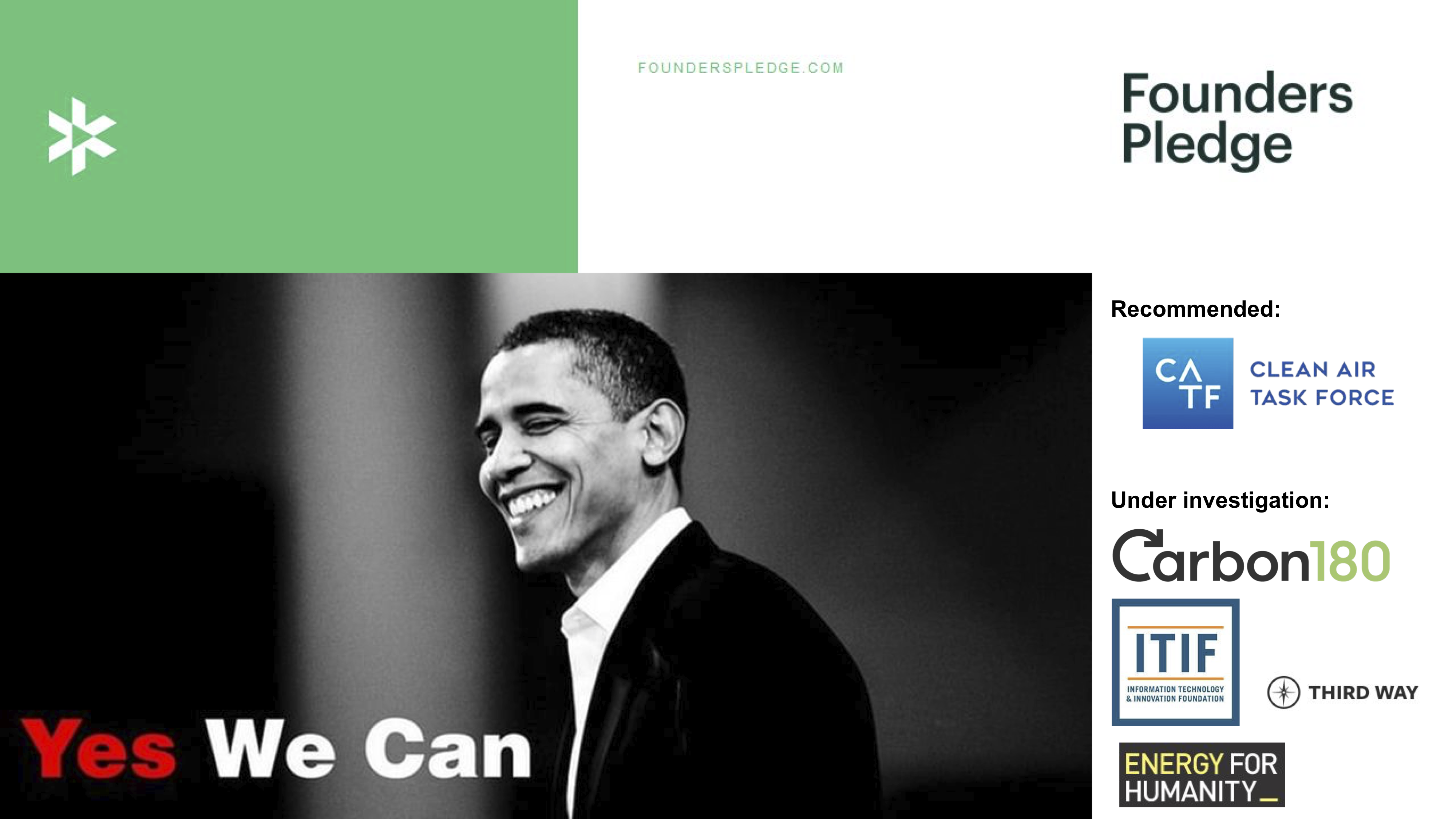
Therefore, our top charity in the space is the Clean Air Task Force, which combines three things. It’s focused on:
1. Neglected technologies
2. Innovation (i.e. making those neglected technologies better)
3. Advocacy (i.e. influencing American energy innovation policy)
The combination of those three different elements makes us think that this is an outstanding opportunity in the climate space and can very likely abate a ton of carbon for $1 (and probably quite a bit less). We’re also looking at other opportunities that go in similar directions.

But to zoom out, the key takeaways from this talk are:
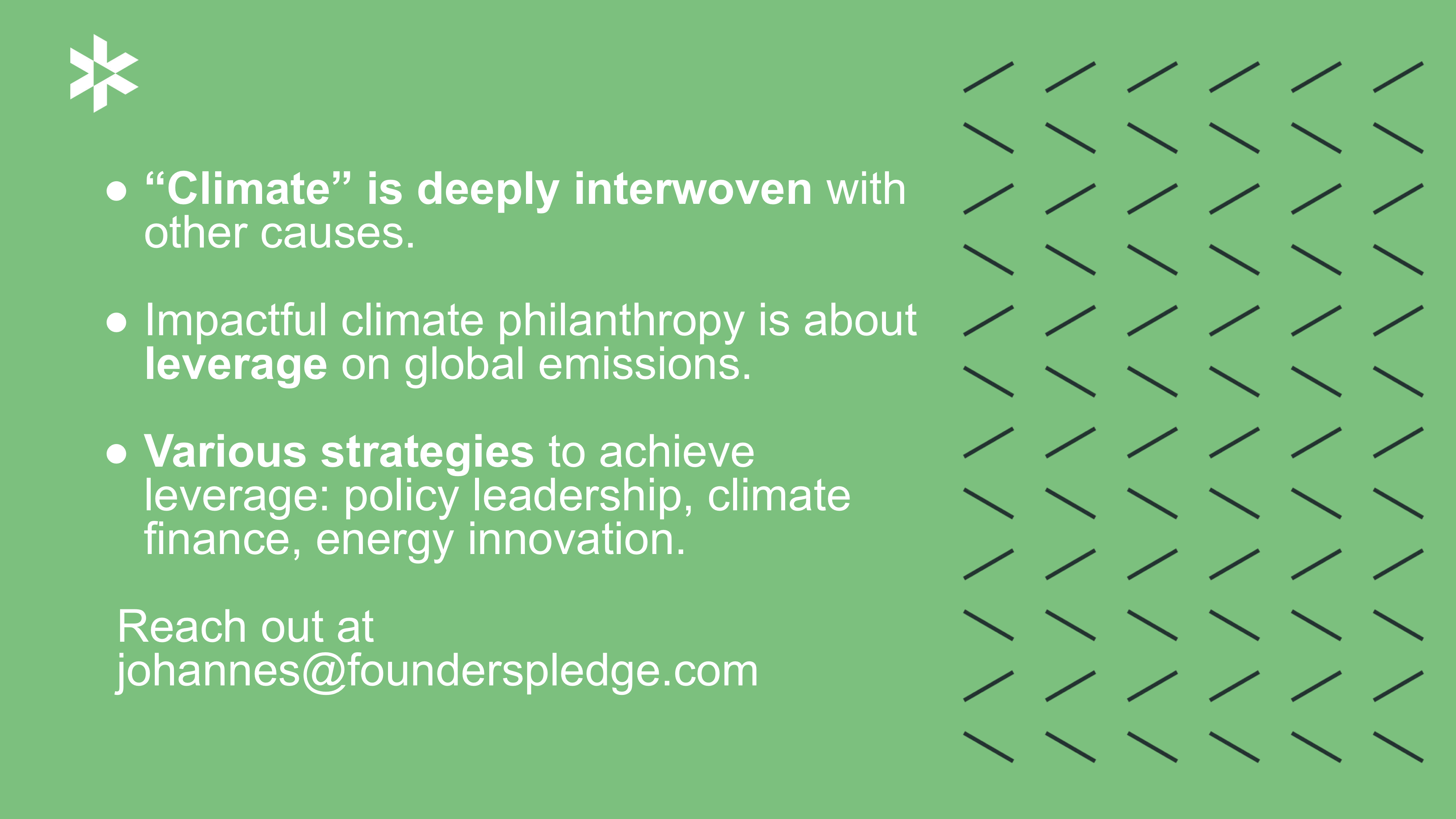
1. Climate is deeply interwoven with other causes and this [affects] how we think about it from an EA perspective.
2. Impactful climate philanthropy is really about leverage on global emissions.
3. There are various strategies to achieve leverage. I talked more about energy innovation, but not for any inherent reason; it makes sense to look at other solutions, like policy leadership and climate finance, as well. The important thing is that it’s plausible to achieve leverage on global emissions in a very cost-effective way.
This is where my talk ends. I'm looking forward to discussing this more and hearing from you. Thank you very much.
Arden: Thanks for the talk, Johannes. I see we have a number of questions [from the audience] already, so let's start with the first one. In your talk, you discussed the funding gap for energy innovation, especially when it comes to neglected technologies like advanced nuclear. Is there other low-hanging fruit for addressing climate change that you think EAs should work on?
Johannes: Absolutely. On the research side, we're currently looking at more opportunities in energy innovation, but there are other strategies that I highlighted in my talk that we’ve spent less time thinking about. In particular, I think it would make sense to [determine] whether policy is a space in which there are highly effective options.
Similarly, I think [EAs could look for] options to increase international climate governance and international climate finance. Those are the research frontiers in terms of EA recommendations, but I do want to stress that right now there's still a [huge] funding gap to be filled in energy innovation. I think energy innovation should be our focus in terms of what we're trying to fund at this point.
Arden: The second question: Do you see any common ground between the effective altruism movement and movements like Extinction Rebellion?
Johannes: I think there's some common ground, but it’s fairly limited. Something that I would like to understand better is what role these broad climate movements [play]. From what I know so far — especially with movements such as extinction rebellion — they're often not very closely tied to scientific information. A lot of the advocacy and pressure go in the right direction, [focusing] more attention on climate, but often in a way that is removed from the science. For example, the claim that we need to reach net-zero emissions by 2030 is something that [those participating in the] extinction rebellion movement would say, and it’s not the result of climate science. These kinds of things make me skeptical.
Also, these are very broad movements. I tend to believe that the main problem with climate change is not the lack of overall societal attention, but rather a lack of effectively focused action. This is why I think supporting highly effective advocacy charities is probably more impactful at the margin. At the same time, those movements are, of course, useful, because they increase the overall attention [that goes to] to the issue.
Arden: I suppose increasing the overall attention will probably [be beneficial], unless there's some reason to think it won’t [direct] attention to [solutions that are] low-hanging fruits and those that we think are most effective.
Johannes: I would disagree a bit. I do think there are ways to increase overall attention that are actually counterproductive. [One example is] framing that is [presented in] catastrophic or extremely urgent [terms] — for example, a framing like, “We have to act now to cut emissions in half by 2030.” That weakens the energy innovation argument and public discourse, because it's easy to then say, “We have to throw everything into acting right now. We don't have to do the smart things that are good for decarbonizing by 2050.”
Also, in my home country, Germany, Fridays for Future essentially has been co-opted by the general green mainstream, which is heavily anti-nuclear and anti-carbon capture. Even though that superficially increases attention to the issue [of climate change], you're not really improving the solutions [being sought]. So the effect is not necessarily one-to-one positive.
Arden: That's a helpful clarification. Speaking of catastrophic framing, do you have thoughts on climate change increasing global instability, and therefore driving other catastrophic risks? I know you mentioned in the talk that people think it's plausible that climate change is a risk factor for other catastrophic risks, but could you say more about that — especially [regarding the risk of] global instability?
Johannes: I think everyone agrees [that’s an issue], but it's really hard [to quantify]. I do think that if you're worried about climate from a longtermist perspective, [the potential for global instability is] the main reason [for concern]; there's a lot to be decided in the next 200 years, and climate change could be a significant driver of conflict, mass displacement, etc., in that time. It’s a very serious concern. But I do find it hard to be more precise.
I also think, in the wider discussion of climate risks beyond the EA community, that [global instability] is often used as a justification to modify action on climate change — for example, with “threat multiplier” framing. On the one hand, I'm quite confident that this is a significant part of the reason we should care about climate change. On the other hand, I do have a certain amount of skepticism, because [the extent of the threat] is essentially unknowable, and [there are currently few] incentives [in place] to find the optimal truth. So I think this is a research frontier.
Arden: But it sounds like you're not that optimistic about it; you said that [determining] how big the effect is seems unknowable.
Johannes: Yes, because this is way more complicated than climate physics.
Arden: Which is already pretty complicated.
Johannes: Yes. I think the issue is complicated because we know that reactions, even to relatively small disturbances, can be amplified in societal processes. How does climate change translate into environmental impacts? How severe are those for human societies? There are huge uncertainties around how society reacts. It’s possible to construct a plausible story in which this could be really bad; it’s also possible to construct a plausible story in which this is not a big issue. And it’s hard to make progress on that [research topic]. I think it would take a lot of effort and additional research.
Arden: Yeah, or maybe an innovative way of going about it.
Another popular [audience] comment is this: It seems like factory farming and meat consumption aren’t a big part of the climate conversation. I'm not sure if this question [pertains to] the broader conversation or to your talk in particular, but could you [address] why that is, in both cases?
Johannes: Actually, I think it has become quite a big part of the broader conversation over the last three or four years. For environmental organizations, in principle, it's easy to blame big business. It's much harder to blame consumption spaces in terms of the politics; most members of Greenpeace, for example, eat meat. That’s why they haven't focused very much on it.
There are two kinds of emissions that are mostly related to meat consumption. One is land use change emissions, which falls under climate finance and relates to one of [Founders Pledge’s] recommendations: the Coalition for Rainforest Nations.
The other kind of emissions [tied to people’s] concern about animal agriculture is methane emissions. Those are short-lived climate pollutants. They will be potent over the next 12 years, but they're not necessarily decisive for long-term warming. That’s the main reason why we're not primarily focused on them right now.
Arden: Okay, thanks. Speaking of lifestyle choices, [audience members] want to know: If they have to fly, would you recommend donating to one of the effective charities that Founders Pledge recommends instead of paying airline-specific offsetting programs?
Johannes: Absolutely. I think that normally, airline-specific offsetting programs are not very good, because a lot of the offsetting is in international climate finance mechanisms, where it's very difficult to make sure that the emissions saved are truly [adding value]. And even if they are, they are much less cost-effective than the most effective climate charities. So [if you want to] maximize the expected value of your contributions — although, of course, for advocacy charities, there is a risk of no progress — you should definitely prefer to give to climate charities over offsetting programs.
Arden: Here’s a related question about different charities’ effectiveness: What do you recommend that people in the effective altruism community do to divert donations from less effective charities to the top climate change organizations?
Johannes: From less effective charities in the climate space?
Arden: Yes.
Johannes: My theory of change is that improving knowledge helps. And what I've tried to do in this talk is [explain] why there are specific charities that are much, much better — and more widely [share the concept of] dimension math, and [issues around] energy and poverty in different countries. This can hopefully move people toward more effective solutions, in a similar way that you would hope to be able to move people from [funding] cat shelters to [funding] advocacy against animal agriculture.
I'm not sure this is a good answer. If there's a better answer out there, I'd really be curious. I think this is what we are trying to do at Founders Pledge. We spend a lot of time speaking to members, trying to shift their perspective and educate them about the nature of the challenge and [how they can best contribute].
Arden: You talked a bit about why donating to effective organizations looks much more [impactful] than making choices about your lifestyle, or doing things like switching to clean energy yourself. Can you talk a little bit more about why that is and what exactly those donations end up translating into, such that they're more valuable?
Johannes: Absolutely. First, why do we think a lot of lifestyle choices are not very impactful? If you switch to clean energy in Europe, for example, a lot of the energy emissions are already on an emissions-trading system. They're capped; the total amount of emissions is set. Also, there are renewable targets set, so the expansion of renewables has already dictated policy. This is a simplified [way of saying that] there isn’t a very clear link between your behavior and the overall amount of energy [used]. The problem is that policy often mitigates [people’s behaviors].
But there's a deeper issue. Even if that [were not the case], advocacy charity — and we spend hundreds of hours trying to get the track record of these charities right — can influence billion-dollar innovation budgets, unlike single-million-dollar organizational budgets. And they can focus on solutions that will have big global impacts, such as driving down technology costs. That's usually just not [possible] in your lifestyle actions, because your lifestyle actions are mostly locally constrained.
Arden: Thanks. [Shifting to] a different subject, what is your view on carbon capture right now?
Johannes: On everything [related to] negative emissions or just [carbon capture]?
Arden: The question says “carbon capture,” but I think he'd probably be interested in your view on negative emissions technologies in general, and carbon capture in particular.
Johannes: There are two kinds of carbon capture. One makes fossil fuel power plants carbon-neutral. This technology has been neglected, but whether or not it takes off is less clear. It would be really relevant if it did, but it's also conceivable that it won’t.
But I think carbon capture as a more general [category] — as in, everything that sucks carbon out of the air and [pertains to] negative emissions — [is critical]. Every model [estimating how to] reach climate targets tells us that [carbon capture] is a crucial part of the picture. And everything that we know about the political economy tells us it’s neglected, because the industries around it don't exist yet.
It's not a very sexy technology, comparatively speaking. It's just cleaning up a mess, and there's nothing inspiring about cleaning up a mess. But it's something we absolutely need to do. We're looking at one charity specifically, Carbon180, that's focused on advocacy around this issue. We think improving support for such technologies is potentially a very high-leverage opportunity, because they're going to be crucial.
Arden: That's a good name, Carbon180.
Johannes: Yes. They rebranded; they had a much clunkier name before: Center for Carbon Removal. So they optimized.
Arden: I agree. This is an improvement.
Okay, I think this should be our last question: Looking forward, what are the priorities for further research on this topic, as you see them?
Johannes: Right now, Funders Pledge is focused on identifying more high-impact charities in the space and covering a broad range [of them]. Therefore, [we want to] identify more energy innovation and advocacy charities, but also go into these other areas that I've mentioned to see whether high-impact opportunities exist there.
Something else that's not a priority for us right now, but I’d be really happy to see someone do is getting more precise about indirect risks from climate change. I think this will be crucial to improve our understanding, as a community, of how we prioritize climate change interventions versus other things.
Arden: One follow-up on that: Do you think the main value of getting more precise about how climate change might be destabilizing comes from helping us figure out how much to prioritize climate change in general? Or is it that we could discover some interventions that actually make climate change a bit less destabilizing?
Johannes: I don't think we'll know, exactly. [This reminds me of] the thinking Open Philanthropy [did when they were] focusing on solar geoengineering, which has its own kind of problems. That’s the only specific recommendation that [comes to mind] based on worst-case scenarios.
Broadly speaking, I think this is more about cause prioritization within EA. It’s much less important for the general public, which I don't think is [as] sensitive to how bad climate change is. There's broad consensus that climate change is really bad, but the degree of action is not determined by, or proportional to, the badness. It’s more [determined by] what's feasible to do politically.
Arden: Yes, and if the broader community diverted energy from working on climate change, they wouldn't necessarily divert it to working on catastrophic biological risks or something [equally pressing]. It doesn't have the same urgency, perhaps, as in the EA community, where people are really flexible with their donations.
Johannes: Yes.
Arden: That's helpful. Well, I think that concludes the Q&A part of this session. [...] Thank you all for watching.
Johannes: Thank you.
Lumpyproletariat @ 2021-10-07T03:45 (+1)
I shared this video with a Discord server and the response was positive. I was worried that no one would watch it, since it was forty minutes long; but apparently many people are more willing to watch a long video than read a short article (well, that could be rational; it probably takes them less time).